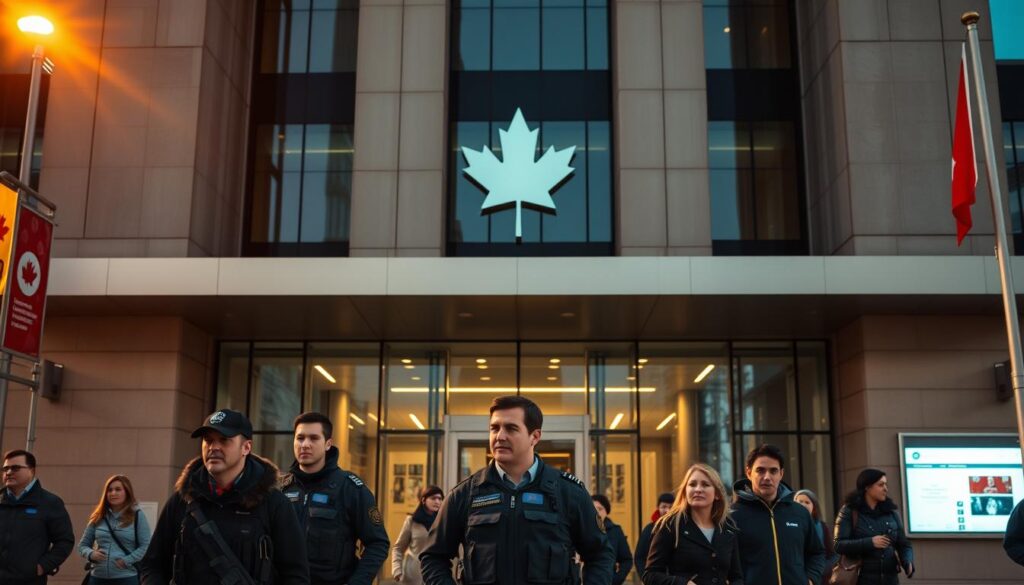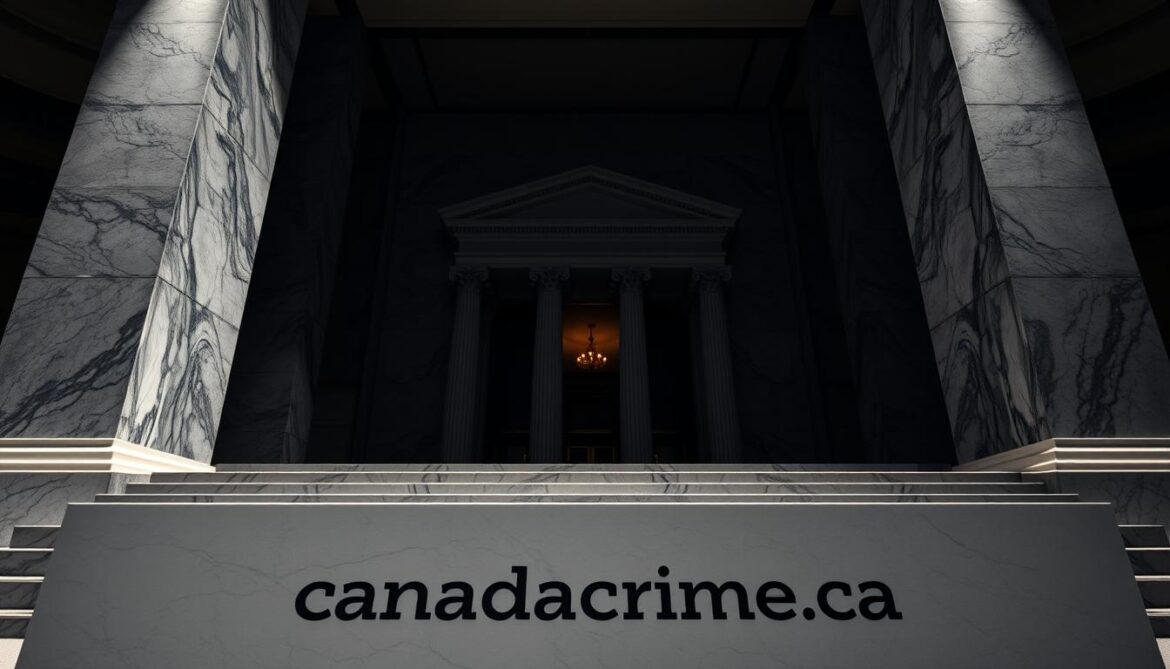Canada has prosecuted over 55 individuals for terrorist activities since 2001. Many Canadians are unaware of the laws governing these serious offenses. The legal framework for terrorism has grown stronger to protect public safety.
The Canadian Parliament enacted the Anti-terrorism Act after September 11, 2001. This law added Part II.I to the Criminal Code of Canada. Sections 83.01 through 83.33 now address terrorism offenses.
These laws cover direct involvement in terrorist activities and instructing others to participate. The penalties are among the most severe in Canadian criminal law. Some offenses carry potential life sentences.
Legal professionals, security experts, and citizens should understand these provisions. The balance between national security and civil liberties is crucial. This balance affects how these laws are applied across Canada.
The Threat of Terrorism in Canadian Society
Terrorism in Canada has changed recently, creating new security concerns for everyone. The Criminal Code defines “terrorist activity” in section 83.01(1). It includes acts committed for political, religious, or ideological purposes to intimidate the public.
These acts aim to compel actions from people, governments, or organizations. Understanding terrorist activities in Canada requires knowing legal definitions and current threat assessments.
Current Terrorism Landscape in Canada
Canada faces diverse terrorism threats from multiple sources. Dangers come from international terrorist groups and domestic extremists. Self-radicalized individuals operating within Canadian borders also pose a risk.
Online platforms have become key spaces for radicalization tactics. They allow extremist ideas to reach vulnerable people easily. Terrorist groups use these digital spaces to spread propaganda and recruitment materials.
The threat spectrum now includes ideologically motivated violent extremism (IMVE). This covers far-right, far-left, and other fringe movements. Domestic threats often develop faster and with fewer warning signs than traditional terrorist cells.
Impact on National Security
Changing terrorist activities have led to big changes in Canada’s security system. CSIS and RCMP have special units to watch for threats. They work to stop radicalization tactics before they cause violence.
These threats have required more security at borders and important places. New laws give security agencies more tools. This raises questions about balancing security and personal freedoms.
Terrorism threats affect community relations and how safe people feel. Minority communities may face more scrutiny. Public spaces now have extra security measures. These changes impact daily life for many Canadians.
Legal Framework: The Criminal Code of Canada
The Criminal Code of Canada is the foundation of counter-terrorism laws in the nation. It provides detailed rules to address terrorist activities. After 9/11, Canada strengthened its legal tools to fight new security threats.
These changes now form the core of Canada’s approach to preventing and prosecuting terrorism-related crimes. The amendments aim to protect citizens while respecting constitutional rights.

Anti-Terrorism Act Overview
The Anti-Terrorism Act, passed in December 2001, was a turning point in Canadian security laws. It added Part II.1 to the Criminal Code (sections 83.01 to 83.33), creating new offenses for terrorist activities.
The law focuses on prevention, making it illegal to prepare for attacks. It gave more power to law enforcement while setting clear legal limits.
The Act balances security needs with constitutional rights. However, this balance is still debated by legal experts and civil rights advocates.
Section 83 Provisions
Section 83 of the Criminal Code covers many aspects of terrorism. It targets various parts of terrorist activities, from funding to direct involvement and training.
Sections 83.02-83.04 make financing terrorism illegal. Sections 83.18-83.23 deal with taking part in and helping terrorist activities. Section 83.21 focuses on teaching or carrying out terrorism.
Defining Terrorist Activity
The Criminal Code defines “terrorist activity” in two parts under section 83.01(1). The first part covers acts in international terrorism treaties Canada has signed.
The second part includes a wider range of actions:
- Acts committed for political, religious, or ideological purposes
- Actions intended to intimidate the public regarding its security
- Activities designed to compel governments or organizations to act
This broad definition helps catch different types of terrorist activities. It also guides courts in interpreting the law.
Terrorist Groups Classification
The Code sets up two ways to classify terrorist groups:
| Classification Type | Legal Basis | Process | Implications |
|---|---|---|---|
| Functional Definition | Section 83.01(1) | Court determination based on activities | Case-by-case assessment during prosecution |
| Listed Entity | Section 83.05 | Cabinet designation on reasonable grounds | Automatic application of terrorism provisions |
| Judicial Review | Section 83.05(5) | Entity can apply for delisting | Limited to specific legal grounds |
When a group is called a terrorist organization, it faces many legal consequences. These include freezing assets, making membership illegal, and harsher penalties for related activities.
The listing process lets the government label organizations as terrorists quickly. This triggers legal actions without needing individual court cases to prove terrorist connections.
Instruction or Commission of an Act of Terrorism: Specific Offenses
Canada’s legal system has specific rules for prosecuting terrorism-related crimes. The Criminal Code targets those who facilitate terrorist activities. These laws aim to prevent attacks and hold those involved accountable.
Canada’s approach reflects its commitment to stopping terrorism before it happens. The laws cover both directing others and carrying out terrorist acts personally.
Elements Required for Prosecution
To prosecute terrorism instruction offenses, the Crown must prove certain elements. Under Section 83.21(1), they must show the accused knowingly instructed someone to help a terrorist group.
The instruction must be given to improve a terrorist group’s ability to conduct activities. For direct commission offenses, prosecutors must prove the accused committed a crime for a terrorist group.

Distinction Between Instruction and Direct Commission
The Criminal Code separates instructing terrorist acts from directly committing them. Section 83.21 covers instructing activities that benefit terrorist groups. Section 83.22 deals with instructing specific terrorist activities.
Both instruction-related offenses can lead to life imprisonment. Section 83.2 focuses on directly committing crimes for terrorist groups.
Burden of Proof Requirements
In terrorism cases, the Crown must prove all elements beyond reasonable doubt. Section 83.21(2) states that an offense can occur even if the instructed activity doesn’t happen.
Prosecution doesn’t require knowing who was instructed. This allows law enforcement to act before terrorist activities are completed.
These laws let authorities stop those inciting violence or giving terrorism instructions early. This approach balances security needs with legal requirements. It aims to protect Canadians while upholding legal principles.
Legal Consequences and Sentencing
Canada’s Criminal Code imposes severe penalties for terrorism offenses. These penalties show Canada’s strong stance against terrorist activities. They aim to protect national security and public safety.
Maximum Penalties
The Criminal Code sets exceptionally harsh penalties for terrorism-related offenses. Instructing others to carry out terrorist activities can lead to life imprisonment.
Other terrorism offenses also carry severe consequences. Participating in a terrorist group can result in up to 10 years in prison. Facilitating terrorist activities may lead to 14 years behind bars.
Committing an offense for a terrorist group carries a maximum penalty of life imprisonment.

Aggravating Factors in Terrorism Cases
Courts must consider specific factors when sentencing terrorism offenses. The Criminal Code requires judges to treat terrorist activities as an aggravating circumstance.
Section 83.26 mandates that sentences for terrorism offenses must be served consecutively. This increases the total time served for those convicted of multiple offenses.
Terrorism Peace Bonds and Recognizance Orders
The Criminal Code provides preventative measures through peace bonds and recognizance orders. These allow courts to impose conditions on individuals suspected of potential terrorism offenses.
Courts can restrict travel, weapons possession, and require electronic monitoring. Regular reporting to authorities may also be mandated.
Violating these conditions is a separate criminal offense. It can result in additional charges and penalties. These measures help authorities prevent terrorist activities before they occur.
- Travel prohibitions
- Weapons restrictions
- Electronic monitoring requirements
- Regular reporting to authorities
Extremist Propaganda and Inciting Violence
Canada’s fight against terrorism focuses on understanding extremist propaganda and incitement to violence. The digital era has changed how radical ideologies spread. Extremist content often leads to more serious terrorist activities.

Online Radicalization Pathways
Online radicalization usually follows a predictable pattern. It starts with exposure to non-violent but extreme viewpoints. These early warning signs often appear as legitimate political or religious discourse.
As people delve deeper, the content becomes more violent and explicit. Echo chambers form where extremist ideas go unchallenged. Social media algorithms unknowingly speed up this process by recommending similar content.
Legal Boundaries Between Free Speech and Incitement
Canadian law distinguishes between protected speech and criminal incitement. The Criminal Code punishes counseling terrorism offenses with up to five years in prison. It also allows authorities to seize materials that promote terrorism offenses.
The challenge lies in balancing fundamental freedoms with public safety. We must protect free expression while preventing genuine threats to national security.
The Canadian Charter protects freedom of expression, but this protection isn’t absolute. Courts carefully weigh these competing interests when applying terrorism-related speech offenses.
| Protected Speech | Potentially Criminal | Clearly Illegal |
|---|---|---|
| Criticizing government policy | Glorifying terrorist acts | Specific instructions for attacks |
| Religious teachings | Dehumanizing rhetoric | Direct calls for violence |
| Political dissent | Sharing terrorist manifestos | Recruiting for terrorist groups |
Internet Monitoring Practices
Canadian security agencies use advanced techniques to fight online extremism. The RCMP and CSIS scan public online spaces for terrorist content. They follow legal frameworks that protect privacy rights.
These agencies work with international partners through various initiatives. They also collaborate with tech companies to remove dangerous content from platforms.
The volume of online content presents significant challenges. Agencies must balance thorough monitoring with respect for civil liberties. They focus resources on the most serious threats to public safety.
Bomb-Making Instructions and Dangerous Knowledge
Dangerous knowledge and terrorist intent create legal and ethical dilemmas in Canadian anti-terrorism efforts. Sharing detailed instructions that could facilitate violence blurs the line between information and criminal facilitation. Canadian authorities must balance security concerns with fundamental freedoms.

Legal Status of Instructional Materials
The Criminal Code of Canada addresses sharing bomb-making instructions with terrorist intent. Knowingly facilitating a terrorist activity carries a maximum fourteen-year sentence.
Directing someone to carry out terrorist activities results in even harsher penalties. Sections 83.21 and 83.22 specifically address instructing terrorist activities, which can lead to life imprisonment.
The law focuses on the intent behind information distribution and knowledge of potential violent outcomes.
Prosecution Challenges
Prosecuting cases involving dangerous instructional materials is challenging for Canadian authorities. The Crown must prove the accused shared information knowingly for terrorist purposes.
Context is crucial in these cases. Prosecutors must link shared information to potential terrorist acts. This requires evidence about the accused’s motivations, connections, and awareness of information use.
Academic Freedom Considerations
The legal framework must account for legitimate research and educational purposes. Scholars, journalists, and educators may have valid reasons to study potentially dangerous topics.
The Criminal Code protects legitimate academic and journalistic activities. However, the line between protected speech and criminal facilitation remains unclear.
Courts must balance security needs against academic inquiry and public information rights. Authorities consider audience, publication context, and safeguards against misuse when evaluating cases.
Financing Terrorism and Material Support
Financing terrorism is a serious crime in Canada. The Criminal Code sets harsh penalties for supporting terrorist groups. Cutting off funding is key to disrupting terrorist operations.
Law enforcement targets this financial weakness. By blocking money sources, they limit extremist groups’ ability to attack Canada.

The Criminal Code has specific provisions targeting the financial aspects of terrorism. Section 83.02 outlaws collecting or providing property for terrorist activities. It carries a ten-year maximum sentence.
Section 83.03 bans making property or services available for terrorism. Section 83.04 addresses using property for terrorist purposes. Both carry ten-year sentences.
Money Laundering Connections
Terrorism financing and money laundering are closely linked. Terrorist groups often use similar methods to hide and move funds. Both conceal the source and purpose of transactions.
Canadian authorities use anti-money laundering and counter-terrorism financing rules. The Proceeds of Crime Act provides tools for tracking suspicious money activities.
Following the money remains one of our most effective strategies in identifying terrorist networks and preventing attacks before they occur.
Charitable Organizations Regulations
Charities face rules to prevent terrorism financing. The Canada Revenue Agency monitors registered charities for potential terrorist links. The CRA can revoke charitable status if connections are found.
Charities must keep detailed records of their activities. They need due diligence procedures, especially for international operations. This ensures funds aren’t used for terrorism.
Financial Intelligence Monitoring
FINTRAC leads financial intelligence monitoring in Canada. It analyzes suspicious transactions that may link to terrorism financing. Financial institutions must report certain transactions and know their clients.
Banks and credit unions report transactions over $10,000. They also report activities suspected of terrorism financing. This creates an early warning system against terrorist threats.
Recruitment Strategies and Radicalization Tactics
Terrorist groups use complex recruitment and radicalization tactics. Canadian law enforcement keeps track of these changing methods. They aim to protect citizens and stop terrorist activities before they happen.
Vulnerable Population Targeting
Terrorist recruiters target vulnerable individuals who may fall for extremist messages. These people often feel isolated, face discrimination, or struggle financially.
Young adults aged 18-29 are especially at risk. They may be looking for purpose or belonging in life.
The Criminal Code of Canada addresses these recruitment activities. Section 83.18(3) makes it illegal to recruit people for terrorist training or activities.

Online Recruitment Methods
Digital platforms are now the main place for terrorist recruitment. Social media, encrypted messaging apps, and forums help recruiters find targets secretly.
Recruiters use clever mind tricks. They send personal messages, play on people’s anger, and create echo chambers for extreme views.
Section 83.181 of the Criminal Code punishes those who leave Canada to join terrorist groups. They can face up to 10 years in prison.
Community-Based Prevention Programs
Canada has created programs to stop radicalization early. These involve teamwork between government, police, mental health experts, and community leaders.
The RCMP’s Countering Violent Extremism program helps at-risk individuals. It offers mentorship and support to keep them from becoming radicalized.
Schools teach critical thinking and media skills. This helps build resistance against extremist messages in communities.
| Recruitment Strategy | Target Audience | Prevention Approach | Legal Response |
|---|---|---|---|
| Social Media Propaganda | Youth (15-25) | Digital literacy education | Section 83.18 prosecution |
| Religious Manipulation | Faith communities | Religious leader engagement | Hate speech laws |
| Exploitation of Grievances | Marginalized groups | Community support programs | Peace bonds |
| Foreign Fighter Recruitment | Adventure-seeking youth | Travel intervention programs | Section 83.181 enforcement |
Law Enforcement and Intelligence Agencies’ Role
Canada’s counter-terrorism approach relies on law enforcement and intelligence agencies working within legal frameworks. These organizations form a network that monitors, investigates, and responds to terrorist threats. Their success depends on clear mandates, specialized skills, and information sharing.

RCMP National Security Operations
The Royal Canadian Mounted Police (RCMP) investigates terrorist activities in Canada. Its Integrated National Security Enforcement Teams (INSETs) conduct criminal investigations related to terrorism and national security threats.
These units operate in major cities, combining resources from various police and intelligence agencies. The RCMP’s National Security Program coordinates counter-terrorism efforts nationwide, focusing on detection, prevention, and evidence gathering.
Terrorism prosecutions require consent from either the Attorney General of Canada or the provincial attorney general. This high-level oversight ensures proper scrutiny of sensitive cases.
CSIS Mandate and Limitations
The Canadian Security Intelligence Service (CSIS) collects and analyzes intelligence on national security threats. CSIS functions primarily as an intelligence agency, not a law enforcement body.
CSIS has significant intelligence-gathering powers but faces important limitations. Its collected information often can’t be used in criminal prosecutions to protect sources and methods.
Both CSIS and the RCMP deny engaging in racial or religious profiling. They focus on behavior-based indicators of extremist propaganda and radicalization.
Interagency Cooperation Framework
The Integrated Terrorism Assessment Centre (ITAC) brings together experts to produce comprehensive threat assessments. These assessments inform national security decisions.
The National Security Joint Operations Centre enables real-time information sharing during critical incidents. This cooperation extends to international allies, particularly the Five Eyes network.
| Agency | Primary Role | Legal Authority | Key Capabilities |
|---|---|---|---|
| RCMP | Law Enforcement | Criminal Code of Canada | Criminal investigations, arrests, evidence collection |
| CSIS | Intelligence Gathering | CSIS Act | Surveillance, threat assessment, intelligence analysis |
| ITAC | Threat Assessment | Government directive | Multi-agency analysis, threat level determination |
| CBSA | Border Security | Customs Act, Immigration Act | Entry screening, interdiction, deportation |
Protection Measures for Canadian Society
Canada has developed a strong framework of protection measures. These empower communities while strengthening national security. The approach balances security concerns with civil liberties and community engagement.
Multiple layers of defense against terrorist threats have been created. These combine proactive government initiatives with strategic public participation.
Public Awareness Campaigns
The Government of Canada regularly conducts public awareness campaigns. These educate citizens about potential threats without fostering fear. The campaigns focus on three critical areas:
- Recognizing early signs of radicalization
- Understanding recruitment strategies used by extremist groups
- Developing critical thinking skills to evaluate extremist propaganda
Canada’s Strategy for Countering Radicalization to Violence provides valuable resources. These tools help Canadians identify concerning behaviors. The strategy emphasizes prevention through education rather than reaction.

Reporting Suspicious Activities
When and How to Report
Early intervention in potential terrorist plots depends on timely reporting. Contact authorities if you observe behaviors indicating terrorism planning. For immediate threats, call 911 immediately.
For non-emergency situations, contact the RCMP National Security Information Network:
- Phone: 1-800-420-5805
- Online: Through the RCMP’s secure reporting tool
Provide specific, factual information when making a report. Include dates, times, locations, and detailed descriptions. Avoid assumptions based on stereotypes or prejudice.
Protection for Informants
The Security of Information Act protects those who report terrorism-related concerns. These safeguards include:
- Confidentiality guarantees for informants
- Legal immunity from civil liability for good-faith reporting
- Access to witness protection programs in serious cases
Community Resilience Building
Building resilient communities is a proactive approach to terrorism prevention. The Cross-Cultural Roundtable on Security facilitates crucial dialogue. It addresses security concerns while ensuring policies respect cultural differences.
| Protection Measure | Primary Focus | Key Benefits | Community Involvement |
|---|---|---|---|
| Public Awareness Campaigns | Education and Prevention | Early identification of threats | High – requires public engagement |
| Reporting Systems | Intelligence Gathering | Rapid response capability | Medium – depends on public reporting |
| Cross-Cultural Roundtable | Dialogue and Understanding | Improved policy development | High – direct community participation |
| RCMP Bias Free Policing | Trust Building | Enhanced community cooperation | Medium – requires ongoing engagement |
The RCMP’s Bias Free Policing Strategy addresses concerns about religious and racial profiling. It maintains effective security measures while building trust. This approach is essential for gathering intelligence and disrupting extremist recruitment.
Conclusion
Canada’s anti-terrorism strategy adapts to changing threats. Few cases have been prosecuted since the Anti-terrorism Act was enacted. This reflects effective prevention and the high bar for terrorism charges.
The legal framework helps authorities stop attacks before they happen. Digital platforms pose new challenges for law enforcement in monitoring potential threats.
Hate-motivated incidents often come before serious terrorism offenses. Recent data shows hate crimes in Canada rose by 32%. Religious and LGBTQ+ communities face significant targeting.
Your role in security is crucial. Understanding legal consequences of terrorism-related activities helps maintain Canada’s safety. Community prevention efforts are also important.
Balancing counter-terrorism and civil liberties is an ongoing challenge. It requires teamwork between government agencies, communities, and citizens like you.

